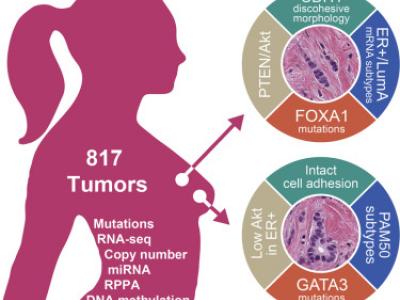Computational Intelligence
Invasive lobular carcinoma (ILC) is the second most prevalent histologic subtype of invasive breast cancer. Here, we comprehensively profiled 817 breast tumors, including 127 ILC, 490 ductal (IDC), and 88 mixed IDC/ILC. Besides E-cadherin loss, the best known ILC genetic hallmark, we identified mutations targeting PTEN, TBX3 and FOXA1 as ILC enriched features. PTEN loss associated with increased AKT phosphorylation, which was highest in ILC among all breast cancer subtypes. Spatially clustered FOXA1 mutations correlated with increased FOXA1 expression and activity.
- Categories:
 633 Views
633 ViewsThis dataset contains the results of the simulation runs of the experiments performed to evaluate and compare the proposed spatial model for situated multi-agent systems. The model was introduced in a paper entitled "BioMASS, a spatial model for situated multiagent systems that optimizes neighborhood search". In this paper we presented a new model to implement a spatially explicit environment that supports constant-time sensory (neighborhood search) and locomotion functions for situated multiagent systems.
- Categories:
 211 Views
211 ViewsA Indústria enfrenta desafios graves e fracassa sem competitividade. Atacando esta problemática, conferiu-se o oferecimento de maior eficiência a processos industriais para promover a produtividade, elevar a qualidade e impulsionar mudanças. A solução desenvolvida incluiu dispositivos com sensores não invasivos, simples de instalar, que contabilizam os itens sendo transportados em linhas de produção.
- Categories:
 890 Views
890 Views
Demonstrating dataset used in one of the experiments.
- Categories:
 121 Views
121 ViewsEach voice sample is stored as a .WAV file, which is then pre-processed for acoustic analysis using the specan function from the WarbleR R package. Specan measures 22 acoustic parameters on acoustic signals for which the start and end times are provided.
The output from the pre-processed WAV files were saved into a CSV file, containing 3168 rows and 21 columns (20 columns for each feature and one label column for the classification of male or female).
- Categories:
 1514 Views
1514 Views
Dataset asscociated with a paper in IEEE Transactions on Pattern Analysis and Machine Intelligence
"The perils and pitfalls of block design for EEG classification experiments"
DOI: 10.1109/TPAMI.2020.2973153
If you use this code or data, please cite the above paper.
- Categories:
 1695 Views
1695 ViewsThe project is conceptualized to 'Geo Web-Based Facility Mapping for Zone-2 in Greater Visakhapatnam Municipal Corporation- GVMC in Visakhapatnam, India'. The main objective is to share the spatial data to the public to help them find the information about the nearest Hospital, ATM, Educational institutions, petrol filling stations, and supermarkets by providing both web map services and web coverage services using QGIS Cloud.
- Categories:
 702 Views
702 ViewsThis dataset is composed of 4-Dimensional time series files, representing the movements of all 38 participants during a novel control task. In the ‘5D_Data_Extractor.py’ file this can be set up to 6-Dimension, by the ‘fields_included’ variable. Two folders are included, one ready for preprocessing (‘subjects raw’) and the other already preprocessed ‘subjects preprocessed’.
- Categories:
 324 Views
324 Views
We develop a general group-based continuous-time Markov epidemic model (GgroupEM) framework for any compartmental epidemic model (e.g., susceptible-infected-susceptible, susceptible-infected-recovered, susceptible-exposed-infected-recovered). Here, a group consists of a collection of individual nodes of a network. This model can be used to understand the critical dynamic characteristics of a stochastic epidemic spreading over large complex networks while being informative about the state of groups.
- Categories:
 206 Views
206 Views



